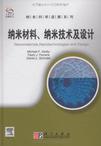纳米材料、纳米技术及设计
出版时间:2010-3 出版社:科学出版社 作者:Michael F. Ashby,Paulo J. Ferreira,Daniel L. Schodek 页数:539
Tag标签:无
前言
There is currently an extraordinary amount of interest in nanomaterials and nanotechnologies, terms now familiar not only to scientists, engineers, architects, and product designers but also to thegeneral public. Nanomaterials and nanotechnologies have beendeveloped as a consequence of truly significant recent advances inthe material science community. Their use, in turn, is expected tohave enormous consequences on the design and engineering ofeverything from common consumer products and buildings all theway through sophisticated systems that support a wealth of applications in the automotive, aerospace, and other industries. Hopesexist for being able to make things smaller, lighter, or work betterthan is possible with conventional materials. Serious problemsfacing society might also be positively addressed via the use ofnanomaterials and nanotechnologies. In the energy domain, forexample, nano-based fuel cells or photovoltaics can potentiallyoffer greater efficiencies than are possible with conventional materials. Developments in nanomaterials and nanotechnologies haveconsequently aroused the interest of many individuals involved inengineering architecture, and product design, whether in the automotive, building, or even the fashion industries.In the excitement surrounding these new materials and technologies, however, their potential can, and has been, frequently overhyped. A mystique surrounds these words that can cloudunderstanding of what nanomaterials and nanotechnologies reallyare and what they can deliver. One of the purposes of this book isto demystify the subject and distinguish what is real from what isnot. Though there is a need to better understand what benefits andcosts might be associated with using nanomaterials, in the designfields little true understanding exists about what these new materials and technologies actually are and how they might be usedeffectively. In the science and engineering domain the situation isoften the converse.
内容概要
纳米材料和技术涉及的领域极为广阔,从物理、化学,能源、信息科学到生物和医学等专业领域,几乎无所不包。本书以材料设计(design)和应用为出发点,阐述材料性能和纳米结构的内在联系,并对纳米材料的制备技术做了较为全面的叙述。 本书前3章对纳米材料和技术进行了简要的概括,第4章从定性和定量的角度,介绍材料的分类。结构和性能。第5章介绍基于材料性能导图.进行材料的选择,优化设计和设计矛盾的解决。第6—8章较为深入地介绍了纳米材料的主要类型和一般特性,以及它们的制备方法和表征手段。第9章针对不同设计环境,从定性的角度出发,探讨纳米材料和技术可能发挥的作用。第10章介绍与建筑,工程、产品设计等领域相关的纳米材料的形式和功能。第11章概述了纳米材料和技术在医疗、—医药等领域,以及改善环境方面的应用,也涉及健康方面的一些问题。最后简介纳米材料和技术在其他工业领域的应用,以及未来的发展前景。
书籍目录
前言 致谢 第1章 纳米材料禾口纳米技术概述 1.1 为什么称之为纳米材料? 1.2 尺度、结构和属性 阅读资料 第2章 历史演化回顾 2.1 材料的发展简史 2.2 自然界中的纳米材料 2.3 艺术和历史文化遗产中发现的纳米材料 阅读资料 第3章 设计关联 3.1 设计中的材料 3.2 产品设计、建筑和工程 3.3 环境、系统和集合 3.4 设计和发展过程 3.5 设计案例 阅读资料 第4章 材料类型、结构和性能 4.1 材料的类型 4.2 材料的内部结构 4.3 力学性质 4.4 热学性质 4.5 电学性质 4.6 磁学性质 4.7 光学性质 4.8 声学性质 阅读资料 第5章 材料性能统计图和应用 5.1 材料性能统计图 5.2 应用统计图表述、筛选、评价和标准化 5.3 图示的限度和统计图标尺指标 5.4 矛盾的解决和处理 第6章 纳米材料:分类和原理 6.1 纳米材料的分类 6.2 尺寸效应 第7章 纳米材料:性能 7.1 力学性能 7.2 纳米材料的热学性能 7.3 电学性能 7.4 磁学性能 7.5 光学性能 7.6 声学性能 7.7 特例 第8章 纳米材料:合成和表征 8.1 纳米尺度材料和结构的合成 8.2 纳米材料的表征 阅读资料 第9章 设计环境和系统 9.1 环境和系统 9.2 结构和受力环境 9.3 受热环境 9.4 电和磁的环境 9.5 光和光学环境 9.6 声和声的环境 9.7 环境和系统的形成:能量 9.8 互动、优雅、智能环境和系统 阅读资料 第10章 纳米材料严晶的形状和功能 第11章 健康和环境领域的纳米材料和纳米技术 第12章 更广泛的内容 索引
章节摘录
插图:Middle East in the ninth century or before and subsequently spreadthrough Egypt, Spain, and other countries. A particularly fine periodof development occurred in Spain with Hispano-Moresque ware, aglazed ceramic made by Moorish potters largely at Malaga in the15th century and later at Manises near Valencia in the 16th century.To produce this type of lusterware, a glaze was first applied over adesign and the piece fired to produce a thin, hard coating. Glazeswere based on dry powdered minerals or oxides, which commonlyincluded tin and copper. After the first firing, the luster coating,consisting of metallic pigments (normally copper or silver compounds) mixed with clays, was brushed on over the glaze. Then thepiece was fired again but at a lower temperature and within a reducing atmosphere (a condition whereby a reducing agent chemicallycauses a change in a material with metallic compounds to a metallic state by removing nonmetallic constituents as it is itself oxidizedby donating free electrons). Afterward the piece was cleaned andpolished to reveal the resulting metallic sheen.Later examples include the "tin-glazed" pottery of 15th and 16thcentury Italy and the "copper glazed" lusterware porcelains ofWedgwood in early 19th century England. Several studies of medieval lusterware via transmission electron microscopy (TEM) havebeen undertaken to understand the composition and microstructure of luster. Results have clearly indicated that various lustercharacteristics can be described in terms of the presence of different levels of silver or copper nanoparticles within the glassymatrix. The associated'surface plasmon effects (described previously) cause the appealing metallic sheen to develop. Again,though the artisans producing lusterware lacked an understanding of the chemical processes that achieved the optical effects andwere unaware that their empirical processes led to the creationof nanoparticles, the craft-based development of the requisiteknowledge was remarkable.
图书封面
图书标签Tags
无
评论、评分、阅读与下载
用户评论 (总计5条)
- 看了一部分,介绍的挺好的。英文原文,正好还可以练习英文阅读
- 正文是英文原版的,前言和目录是翻译后的。看英文的理解可以更透彻,毕竟翻译很难把作者的意思完全表达出来嘛~
- 还是不错的,即使是英文也浅显易懂
- 该书对教学和科研都有很好的参考价值
- 整体上而言,太泛泛了,没有精的感觉,很多有需要的知识点一带而过,没有详细深入的讲解!只能作为一般的科普读物
相关图书
- 伺服电机应用技术
- 流域水文模型
- 现代导航、制导与测控技术
- 卫星光网络技术
- Kalman滤波理论及其在导航系统中的应用
- 近世代数习题解答
- 混合励磁电机的结构及原理
- TFT LCD面板设计与构装技术
- 中国髹漆工艺与漆器保护
- 中国传世玉器全集(1~8卷)
- 区域溢出
- 中国大学及学科专业评价报告
- 图书馆个性化知识服务发展报告
- 首都标准化
- 中国战略环境评价理论与实践
- 中国大山包黑颈鹤自然保护区植物
- 全球气候变化对亚高山针叶林树木的影响
- 现代工程与施工企业管理
- 伏牛山药用植物志(第二卷)
- 软件质量保障原理与实践
- PIC单片机编程
- PIC单片机基础与传感器应用
- 大维随机矩阵的谱分析
- 图的可嵌入性理论
- 基于生物网络的智能控制与优化
